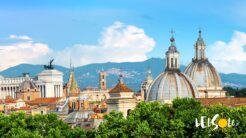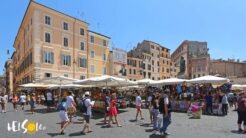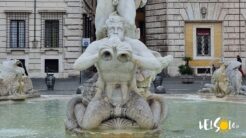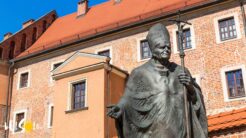Every year, Rome experiences a siege of tourists during Easter. The Stations of the Cross in the Colosseum or the mass led by the Pope in the Vatican are just some of the many attractions. What else is worth knowing about Easter in Rome? What does Easter in Rome and the Vatican usually look like?
Easter Sunday will fall on the 31st of March in 2024.
Ligurian palms
On Palm Sunday, the Vatican is full of olive trees and specially woven parmureli from Liguria. Why from there specifically? According to a legend, Pope Sixtus V ordered a 26-metre obelisk to be erected in St Peter’s Square. When the ropes were already so taut that a moment more and they’d break, a young sailor shouted to pour water over them. This saved the rope and the obelisk was put in place successfully. The satisfied Pope asked the man what he could give him in return for his help. The humble man asked for a lifetime privilege for himself and his descendants to deliver palms to the Pope on Palm Sunday. Since then, every Easter Rome gets handmade palms from the towns of San Remo and Bordighera. The composition consists of 3 intertwined leaves that symbolise the Holy Trinity.
Stations of the Cross Procession in the Colosseum
A unique Stations of the Cross procession takes place on Good Friday. The tradition was originally started by Pope Benedict XIV in 1750 – he also placed a cross in the middle of the amphitheatre. The custom was discontinued after the unification of Italy and all the chapels and the cross were removed. After the signing of the Lateran Treaties, it returned to the area of the Colosseum – not to the centre, but to a side area. The forgotten tradition was revived once by Pope John XXIII, while it was completely renewed by Pope Paul VI in 1964.
The Way of the Cross is always a grand event there, as the Pope leads the procession himself. As of midday, the streets around the amphitheatre are already closed and buses take detours. The celebrations begin at 9 pm and are broadcast worldwide.
Flowers straight from the Netherlands
On Easter Sunday, everyone marvels at the beautiful flower decorations that are arranged on the steps leading up to St Peter’s Basilica. This work of art is the gift of Dutch florists who have been beautifying the Vatican for more than 35 years.
Specialists already start the preparations on Good Friday. On Holy Saturday, they arrange the prepared decorations in St Peter’s Square. The flowers remain on the steps for only a few days and they’re later moved to the Vatican Gardens.
Where did this tradition come from? During John Paul II’s visit to the Netherlands in 1985, there were numerous anti-pope protests in the streets. Not everyone, however, was against the Pope. The local florists organised beautiful flower decorations for the occasion – they were so popular that the Dutch took it upon themselves to make Easter flower decorations every year. The tradition was only put on hold for a moment due to the pandemic, but has since been reinstated and you can expect the square to turn into a garden in 2024 too.
Easter Monday
Easter Monday is known as Pasquetta or Luned or Lunedì dell’Angelo to the Italians. On this day, Romans, like the rest of Italians, spend time with family and friends outdoors. From early in the morning, everyone packs up food and heads out of town or to the nearby parks. A favourite picnic spot for Romans is Villa Pamphili. If you’d like to partake in the picnics too, be sure to head out very early in the morning as traffic gets there fast. And if you were in such a rush that you forgot all the picnic food for the picnic, don’t worry, there’s a restaurant there that sells ready-made picnic baskets full of goodies.
Easter food in Rome
Rome combines traditions from all parts of Italy. Children look forward to chocolate eggs with a surprise inside while adults feast on more adulty Easter delicacies. For example, on corallina (a special salami), coratella (lamb offal with fried artichokes), torta pasqualina (puff pastry stuffed with spinach or artichokes) or Easter pizza al formaggio (with very salty cheese).
And what’s for dessert? A traditional yeast cake in the shape of a dove called colomba or pastiera napoletana – a shortcrust pastry with a filling of cooked cereal, ricotta, topped with candied cedar and some orange flavour.
See also:






